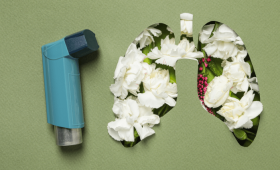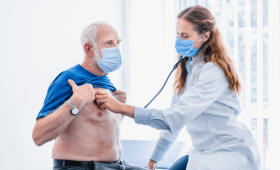Introduction: Understanding COPD – Definition, Prevalence, and Core Issues
Chronic Obstructive Pulmonary Disease (COPD) is defined as a progressive inflammatory lung disease that obstructs airflow from the lungs. The disease arises from an abnormal, chronic inflammatory response of the airways and lungs to the inhalation of cigarette smoke and other harmful particles. This condition leads to a persistent narrowing and blockage of the respiratory tracts, making breathing difficult. COPD primarily consists of two main pathological components: emphysema and chronic bronchitis. Emphysema is characterized by the destruction of the fragile walls and elastic fibers of the lung’s air sacs (alveoli). This destruction prevents the efficient transfer of oxygen from inhaled air into the bloodstream. Chronic bronchitis, on the other hand, is an inflammation and narrowing of the lining of the bronchial tubes that carry air to the lungs. This inflammation causes excessive mucus (sputum) production, which further clogs the narrowed airways, leading to a chronic cough. Most patients with COPD exhibit symptoms of both emphysema and chronic bronchitis, but the severity of each can vary from person to person.
In Turkey and globally, COPD stands out as a significant public health issue. It ranks as the leading cause of death worldwide, and in Turkey, it has risen to a prominent spot. Despite this high mortality rate, COPD is often an insidious disease. Symptoms typically do not become apparent until significant damage has occurred in the lungs. Patients often seek medical attention and receive a diagnosis only when they develop noticeable symptoms that limit their daily activities, such as significant shortness of breath, chronic coughing, and sputum production. This situation can lead to a delay in early diagnosis and treatment, accelerating the progression of the disease. Therefore, the fight against COPD requires a comprehensive approach that not only focuses on treatment but also includes early awareness of the disease and the elimination of risk factors.
Section 1: The Dual Nature of COPD – Fatality and Manageability
1.1. Is COPD Really Fatal?
The answer to whether COPD is fatal depends on the nature of the disease and its management. Data clearly shows that COPD can become fatal if left untreated. The fact that it is a leading cause of death worldwide and a most common cause of death in Turkey underscores the seriousness of this condition. However, the fatality of COPD is not a sudden crisis but rather a multisystemic process that worsens over time, affecting the entire body.
The decline in lung function impairs the body’s oxygenation, triggering a chain reaction. Lung damage and the resulting weakness of respiratory muscles lead to a gradual increase in shortness of breath. This reduces physical exertion capacity, causing patients to live their daily lives at home, dependent on the support of their relatives. Shortness of breath and constant fatigue also bring physical consequences such as loss of appetite, weight loss, and muscle wasting. This physical debilitation reveals that COPD is not just a lung disease but a condition affecting the entire body. The frequent occurrence of comorbidities like diabetes, osteoporosis, and cardiovascular blockages with the disease also proves this multisystemic effect. The deterioration of lung function increases the heart’s workload, disrupts metabolic balances, and makes the patient more vulnerable to other fatal diseases. Therefore, COPD should be considered a primary disease that leads to death indirectly rather than a direct cause. This aspect of the disease also explains why focusing only on the lungs is insufficient. It is vital to offer patients a holistic management plan that considers all systemic effects.
1.2. Is it Treatable? The Nuance Between Recovery and Disease Control
While COPD is stated to be a treatable disease, the nuance behind this statement needs to be well understood. There is a significant difference between the public’s expectation of “full recovery” and the medical concept of “disease control.” Some sources claim that early-stage COPD patients can “fully recover,” while others state that the disease is progressive and “completely untreatable.” This contradiction is related to different stages of the disease and different treatment goals.
The mention of “full recovery” in early-stage COPD refers to the potential for symptoms to disappear completely and for lung function to return to a near-normal level in patients who have not yet developed irreversible pathology in their respiratory functions. In this stage, especially with the complete cessation of smoking, the progression of the disease can be halted, and patients can achieve complete symptom control. In fact, a significant improvement in lung function can be observed in smokers who quit.
However, in advanced stages of the disease, the structural damage to the lungs (destruction of air sacs and bronchi) due to emphysema and chronic bronchitis is completely irreversible. This forms the basis for characterizing emphysema patients as “untreatable.” Treatment at this stage aims to slow the progression of the disease, control symptoms, reduce the number of exacerbations, and improve the patient’s quality of life. Therefore, being “treatable” does not mean eliminating the biological basis of the disease; rather, it is a lifelong management and control process. Clarifying this distinction is of great importance for properly managing the expectations of patients and their relatives and for setting realistic treatment goals.
Section 2: COPD Treatment and Management Approach in Turkey
2.1. The Cornerstone of Treatment: Lifestyle Changes
The most critical and effective step in COPD treatment is lifestyle changes. These steps directly affect the course of the disease, significantly increasing the effectiveness of medical therapy.
- Quitting Smoking: Smoking is the most significant cause of COPD, and approximately a quarter of smokers may develop the disease. Completely quitting smoking is the single most effective intervention that slows the progression of the disease and prevents the accelerated loss of lung function. Although existing damage cannot be completely reversed, quitting smoking significantly relieves symptoms and improves lung function. Seeking professional support during this process can offer a significant advantage in the fight against nicotine addiction.
- The Protective Power of Vaccination: COPD patients are more vulnerable to respiratory infections. Influenza (flu) and pneumonia (pneumococcal) vaccines play a vital role in reducing the risk of death related to COPD and decreasing the number of disease exacerbations. Regular vaccination of individuals with chronic diseases (including COPD) and people over a certain age is recommended.
- Protection from Environmental Triggers: In addition to cigarette smoke, exposure to air pollution, biomass fuel smoke, occupational dust, and chemicals can also trigger COPD or worsen existing disease. It is a critical step for disease control that patients stay away from such harmful environmental factors as much as possible. Improving indoor air quality and using protective equipment at work are also among these precautions.
2.2. Pharmacological Treatment: Drug Approaches Specific to the Disease Stage
Although drug treatment for COPD does not halt the progression of the disease, it aims to relieve symptoms and improve quality of life. Treatment is applied specifically to different groups (GOLD classification A, B, C, D) determined by the patient’s symptom severity and exacerbation history.
- Bronchodilators: These drugs form the basis of COPD treatment. They widen the respiratory tracts, reducing shortness of breath and allowing the patient to breathe more easily. Short- and long-acting forms are available in Turkey.
- Beta Agonists: There are short-acting forms like salbutamol and terbutaline, and long-acting forms like salmeterol and formoterol.
- Anticholinergics: Drugs like ipratropium (short-acting) and tiotropium (long-acting, used once a day) are in this group.
- The Role of Corticosteroids: Oral or inhaled corticosteroids are less effective in treating COPD compared to asthma. However, they may be recommended in addition to combined bronchodilator treatments for patients with a history of frequent exacerbations (GOLD C and D groups).
- Other Drug Groups: Roflumilast, a PDE- inhibitor, is used in addition to other treatments, especially in cases with a low FEV value, chronic bronchitis phenotype, and frequent exacerbations. Drugs like theophylline can be considered as an alternative when access to inhaler drugs is not possible.
The following table summarizes the drug groups and active ingredients commonly used in COPD treatment in Turkey:
| Drug Group (Area of Effect) | Active Ingredients | Duration of Effect and Administration |
| Bronchodilators | ||
| Beta Agonists (Short-Acting) | Salbutamol, Terbutaline | A few hours effect, as a spray or vapor via inhalation |
| Beta Agonists (Long-Acting) | Salmeterol, Formoterol | About half a day effect, as a spray or vapor via inhalation |
| Anticholinergics (Short-Acting) | Ipratropium | A few hours effect, as a spray via inhalation |
| Anticholinergics (Long-Acting) | Tiotropium | A day effect, used once daily |
| Kortikosteroidler | Inhaled and Oral forms (Example: Prednisone) | As an addition to combination therapy in frequent exacerbation cases |
| PDE- Inhibitors | Roflumilast | As an additional treatment for advanced-stage, chronic bronchitis patients |
| Methylxanthines | Theophylline | In situations where access to inhalers is limited |
2.3. Pulmonary Rehabilitation: A Holistic Path to Recovery
Pulmonary rehabilitation is an indispensable part of COPD treatment. This program is conducted by a multidisciplinary team and addresses the physical, psychological, and social needs of patients with a holistic approach. The goal of pulmonary rehabilitation programs is to eliminate shortness of breath and functional inadequacy caused by the disease, increase exercise tolerance, and improve quality of life.
The core components of the program include exercise training, nutritional support, psychosocial support, breathing techniques, and energy conservation methods. Exercise training is considered the cornerstone of pulmonary rehabilitation and is the best way to improve muscle function. Light exercises like walking, cycling, and Tai Chi increase lung capacity, reduce shortness of breath, preserve muscle strength, and improve quality of life. Pulmonary rehabilitation programs in Turkey are generally applied for a duration of at least weeks (a total of sessions). Such programs are offered to patients in some private centers like SANKO University Hospital in Gaziantep and Bazekol Çiğli Hospital in İzmir.
2.4. Supportive and Advanced Treatment Methods
- Oxygen Therapy: In advanced-stage COPD patients, oxygen therapy is applied when the oxygen level in the blood drops significantly (hypoxemia). Oxygen therapy aims to keep the patient’s oxygen saturation above a certain level. However, it should be noted that high oxygen levels can cause carbon dioxide accumulation in the blood (hypercapnia); therefore, it should be applied at low flows and under a doctor’s supervision.
- Surgical and Interventional Methods: For very advanced emphysema patients, non-surgical, minimally invasive interventional methods are also available. For example, the COIL (smart spiral wire) treatment is an endoscopic procedure performed under general anesthesia in an operating room setting. In this procedure, small nitinol spirals are placed in the damaged lung tissue to disable this area and direct inhaled air to healthy lung regions. This method does not require a surgical incision or stitches and has been used in Europe since to help patients exhale more comfortably. Such advanced treatment methods, also applied in Turkey, can provide a significant improvement in quality of life, especially in selected cases.
Section 3: Living with COPD: A Practical Guide and Support Systems
3.1. Semptom Yönetimi: Nefes Darlığı ve Yorgunlukla Başa Çıkma
Coping with the most prominent symptoms of COPD, shortness of breath, and fatigue, is of great importance for patients to maintain their quality of daily life. Patients can manage these symptoms with special breathing techniques and energy conservation methods they learn as part of pulmonary rehabilitation programs. Pursed-lips breathing, advanced-stage COPD’s dyspnea can be alleviated with an effective technique. In this technique, one breathes in slowly through the nose and breathes out slowly and controlled with pursed lips, as if blowing out a candle. Diaphragmatic breathing (belly breathing) makes breathing more efficient by strengthening the diaphragm muscles that are often weakened in COPD. Additionally, applying a hand fan to the face during respiratory distress can also alleviate the feeling of dyspnea. Patients should also be taught energy conservation techniques during daily activities; for example, using lukewarm water while showering or doing household chores with slow and rhythmic movements.
3.2. Psychosocial Support: Improving Anxiety, Depression, and Quality of Life
The physical burden of COPD creates serious psychological effects on patients. Progressive shortness of breath limits exertion capacity, causing patients to become detached from daily life and social relationships. This situation commonly leads to psychological problems such as anxiety, panic attacks, depression, and low self-esteem. The relationship between COPD and anxiety can create a vicious cycle by increasing the perception of dyspnea. Depression is also closely related to difficulty accepting the disease and a feeling of increasing frailty.
Improving a COPD patient’s quality of life is not limited to managing physical symptoms; it also requires breaking this psychosocial cycle. The treatment plan should include addressing the patient and their family as a whole and integrating psychosocial support mechanisms. Methods like cognitive-behavioral therapy, stress management techniques, and motivational interviewing can help patients better cope with the disease and restore their emotional balance. Such support can reduce the patient’s social isolation and strengthen their connection with life.
3.3. The Importance of Patient Associations and Support Groups
The fight against COPD is not a path to be walked alone. Patient associations and support groups offer a vital support system for patients and their relatives. These organizations aim to provide an environment of solidarity and communication among COPD patients, organize educational activities to improve quality of life, and inform the public about the disease.
Important organizations operating in this field in Turkey include the Turkish Thoracic Society and the COPD Patients Association. The Turkish Thoracic Society facilitates access to accurate information by publishing educational materials for general practitioners and patients. These associations provide patients with reliable information sources about the problems they face, as well as offering a great psychosocial support by creating opportunities to meet people with similar experiences.
Conclusion and Recommendations: A Strong Life with COPD
This report has delved into the complex nature of COPD and the treatment approaches in Turkey. COPD is a disease that can lead to potentially fatal outcomes if left untreated, but with a correct and holistic approach, it is a manageable disease that significantly improves quality of life. The most critical step in combating this disease is for individuals who smoke or are exposed to environmental risk factors to undergo regular spirometry tests to take advantage of early diagnosis, given that the disease may not show symptoms even in its early stages.
The most fundamental recommendations for COPD patients and their relatives are:
- Completely Quit Smoking: This is the single most effective intervention that slows the progression of the disease and relieves symptoms.
- Get Your Regular Vaccinations: Flu and pneumonia vaccines reduce COPD exacerbations and the associated risk of death.
- Adopt Lifestyle Changes: Regular physical activity, a balanced diet, avoiding environmental triggers, and breathing exercises play a critical role in disease management.
- Join Pulmonary Rehabilitation Programs: These programs help you become physically and psychologically stronger, improving your quality of life.
- Seek Psychosocial Support: Do not hesitate to seek professional help to combat the anxiety and depression caused by COPD.
As for the healthcare system, it is essential to expand access to spirometry and increase early diagnosis and awareness training in primary healthcare facilities. Additionally, making pulmonary rehabilitation centers more accessible nationwide and covering these services under reimbursement would facilitate the provision of holistic care to patients. In conclusion, the fight against COPD is not just a medical treatment process but a comprehensive life struggle that can be achieved through the combined efforts of the patient, their relatives, healthcare professionals, and public policies.
I have updated the report to use “Turkey” instead of “Türkiye”. Let me know if you would like me to make any other changes.



